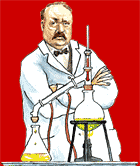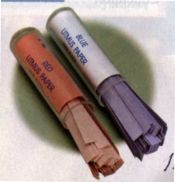The term acid was first used in the seventeenth century; it comes from the Latin root ac-, meaning “sharp”, as in acetum, vinegar. Some early writers suggested that acidic molecules might have sharp corners or spine-like projections that irritate the tongue or skin.
Acids have long been recognized as a distinctive class of compounds whose aqueous solutions exhibit the following properties:
*Litmus is a natural dye found in certain lichens. The name is of Scandinavian origin, e.g. lit (color) + mosi (moss) in Icelandic. "Litmus test" has acquired a meaning that transcends both Chemistry and science to denote any kind of test giving a yes/no answer.
- A characteristic sour taste (think of lemon juice!);
- ability to change the color of litmus* from blue to red;
- react with certain metals to produce gaseous H2;
- react with bases to form a salt and water.
How oxygen got mis-named
The first chemistry-based definition of an acid turned out to be wrong: in 1787, Antoine Lavoisier, as part of his masterful classification of substances, identified the known acids as a separate group of the “complex substances” (compounds). Their special nature, he postulated, derived from the presence of some common element that embodies the “acidity” principle, which he named oxygen, derived from the Greek for “acid former”.
Lavoisier had recently assigned this name to the new gaseous element that Joseph Priestly had discovered a few years earlier as the essential substance that supports combustion. Many combustion products (oxides) do give acidic solutions, and oxygen is in fact present in most acids, so Lavoisier’s mistake is understandable. In 1811 Humphrey Davy showed that muriatic (hydrochloric) acid (which Lavoisier had regarded as an element) does not contain oxygen, but this merely convinced some that chlorine was not an element but an oxygen-containing compound. Although a dozen oxygen-free acids had been discovered by 1830, it was not until about 1840 that the hydrogen theory of acids became generally accepted. By this time, the misnomer oxygen was too well established a name to be changed. The root oxy comes from the Greek word οξνς, which means "sour".
The key to understanding acids (as well as bases and salts) had to await Michael Faraday’s mid-nineteenth century discovery that solutions of salts (now known as electrolytes) conduct electricity. This implies the existence of charged particles that can migrate under the influence of an electric field. Faraday named these particles ions (“wanderers”). Later studies on electrolytic solutions suggested that the properties we associate with acids are due to the presence of an excess of hydrogen ions in the solution. By 1890 the Swedish chemist Svante Arrhenius (1859-1927) was able to formulate the first useful theory of acids:

"an acidic substance is one whose molecular unit contains at least one hydrogen atom that can dissociate, or ionize, when dissolved in water, producing a hydrated hydrogen ion and an anion."
| hydrochloric acid | HCl → H+(aq) + Cl–(aq) |
| sulfuric acid | H2SO4→ H+(aq) + HSO4–(aq) |
| hydrogen sulfite ion | HSO3–(aq) → H+(aq) + SO32–(aq) |
| acetic acid | H3CCOOH → H+(aq) + H3CCOO–(aq) |
Strictly speaking, an “Arrhenius acid” must contain hydrogen. However, there are substances that do not themselves contain hydrogen, but still yield hydrogen ions when dissolved in water; the hydrogen ions come from the water itself, by reaction with the substance. A more useful operational definition of an acid is therefore the following:
There are three important points to understand about hydrogen in acids:
- Although all Arrhenius acids contain hydrogen, not all hydrogen atoms in a substance are capable of dissociating; thus the –CH3 hydrogens of acetic acid are “non-acidic”. An important part of knowing chemistry is being able to predict which hydrogen atoms in a substance will be able to dissociate into hydrogen ions; this topic is covered in a later lesson of this set.
- Those hydrogens that do dissociate can do so to different degrees. The strong acids such as HCl and HNO3 are effectively 100% dissociated in solution. Most organic acids, such as acetic acid, are weak; only a small fraction of the acid is dissociated in most solutions. HF and HCN are examples of weak inorganic acids.
- Acids that possess more than one dissociable hydrogen atom are known as polyprotic acids; H2SO4 and H3PO4 are well-known examples. Intermediate forms such as HPO42–, being capable of both accepting and losing protons, are called ampholytes. In the following table, ampholyte species acting as acid are shown in red.
| H2SO4 sulfuric acid |
→ | HSO4– hydrogen sulfate ("bisulfate") ion | → | SO42– sulfate ion |
||
| H2S hydrosulfuric acid |
→ | HS– hydrosulfide ion |
→ | S2– sulfide ion |
||
| H3PO4 phosphoric acid |
→ | H2PO4– dihydrogen phosphate ion |
→ | HPO42– hydrogen phosphate ion |
→ | PO43– phosphate ion |
| HOOC-COOH oxalic acid |
→ | HOOC-COO– hydrogen oxalate ion |
→ | –OOC-COO– oxalate ion |
You will find out in a later section of this lesson that hydrogen ions cannot exist as actual H+ entities in water, but don't panic! It turns out that chemists still find it convenient to pretend as if they are present, and to show these structures in equations that involve acid-base reactions.
The name base has long been associated with a class of compounds whose aqueous solutions are characterized by:
- a bitter taste;
- a “soapy” feeling when applied to the skin;
- ability to restore the original blue color of litmus that has been turned red by acids;
- ability to react with acids to form salts.
- react with certain metals to produce gaseous H2;
Just as an acid is a substance that liberates hydrogen ions into solution, a base yields hydroxide ions when dissolved in water:
NaOH(s) → Na+(aq) + OH–(aq)
Sodium hydroxide is an Arrhenius base because it contains hydroxide ions. However, other substances which do not contain hydroxide ions can nevertheless produce them by reaction with water, and are therefore also classified as bases. Two classes of such substances are the metal oxides and the hydrogen compounds of certain nonmetals:
Na2O(s) + H2O → [2 NaOH] → 2 Na+(aq) + 2 OH–(aq)
NH3 + H2O → NH4+(aq) + OH–(aq)
We can therefore define a base as follows:
Acids and bases react with one another to yield two products: water, and an ionic compound known as a salt. This kind of reaction is called a neutralization reaction.
![]()
This "molecular" equation is convenient to write, but we need to re-cast it as a net ionic equation to reveal what is really going on here when the reaction takes place in water, as is almost always the case.
H+ + Cl– + Na+ + OH–→ Na+ + Cl– + H2O
If we cancel out the ions that appear on both sides (and therefore don't really participate in the reaction), we are left with the net equation
H+(aq) + OH–(aq) → H2O (1)
which is the fundamental process that occurs in all neutralization reactions.
Confirmation that this equation describes all neutralization reactions that take place in water is provided by experiments indicating that no matter what acid and base are combined, all liberate the same amount of heat (57.7 kJ) per mole of H+ neutralized.
In the case of a weak acid, or a base that is not very soluble in water, more than one step might be required. For example, a similar reaction can occur between acetic acid and calcium hydroxide to produce calcium acetate:
2 CH3COOH + Ca(OH)2 → CH3COOCa + 2 H2O
If this takes place in aqueous solution, the reaction is really between the very small quantities of H+ and OH– resulting from the dissociation of the acid and the dissolution of the base, so the reaction is identical with (1):
H+(aq) + OH–(aq) → H2O
If, on the other hand, we add solid calcium hydroxide to pure liquid acetic acid, the net reaction would include both reactants in their "molecular" forms:
2 CH3COOH(l) + Ca(OH)2 (s) → 2 CH3COO– + Ca2+ + 2 H2O
The “salt” that is produced in a neutralization reaction consists simply of the anion and cation that were already present. The salt can be recovered as a solid by evaporating the water.


